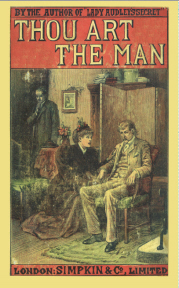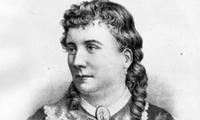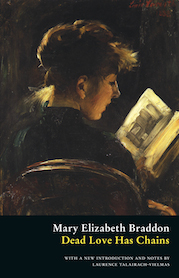
Thou Art the Man (1894)
Mary Elizabeth Braddon, Edited by Laurence Talairach-Vielmas
Ten years ago, a shocking murder cut short a blossoming romance between beautiful young heiress Sibyl Higginson and her cousin Brandon Mountford. When Mountford, an epileptic subject to seizures and memory loss, awakened near a bloody corpse, he was forced to escape to avoid execution for the crime. The years passed, nothing was heard of Mountford, and it was supposed he had either died or fled the country.
A decade later, Sibyl, now Lady Penrith, is travelling along a desolate moor when a crazed man stops her carriage and hands her a scrawled note. Believing the note to be from Mountford, Sibyl sets out to investigate, and with the help of her niece Coralie Urquhart she will uncover the long-hidden truth behind the murder and the horrible fate of Brandon Mountford!
Thou Art the Man (1894) is a thrilling and fast-paced novel of murder and mystery. It is also, as Laurence Talairach-Vielmas discusses in her introduction to this edition, a fascinating look at the ways Braddon adapted late-Victorian theories of heredity, disease, and criminology into her fiction. This edition reprints the unabridged text of the 1895 "yellowback" edition, complete with a facsimile of its cover, and includes a new introduction and explanatory notes.
Mary Elizabeth Braddon, Edited by Laurence Talairach-Vielmas
Ten years ago, a shocking murder cut short a blossoming romance between beautiful young heiress Sibyl Higginson and her cousin Brandon Mountford. When Mountford, an epileptic subject to seizures and memory loss, awakened near a bloody corpse, he was forced to escape to avoid execution for the crime. The years passed, nothing was heard of Mountford, and it was supposed he had either died or fled the country.
A decade later, Sibyl, now Lady Penrith, is travelling along a desolate moor when a crazed man stops her carriage and hands her a scrawled note. Believing the note to be from Mountford, Sibyl sets out to investigate, and with the help of her niece Coralie Urquhart she will uncover the long-hidden truth behind the murder and the horrible fate of Brandon Mountford!
Thou Art the Man (1894) is a thrilling and fast-paced novel of murder and mystery. It is also, as Laurence Talairach-Vielmas discusses in her introduction to this edition, a fascinating look at the ways Braddon adapted late-Victorian theories of heredity, disease, and criminology into her fiction. This edition reprints the unabridged text of the 1895 "yellowback" edition, complete with a facsimile of its cover, and includes a new introduction and explanatory notes.
|
BOOK DETAILS
Trade paper ISBN-13: 978-1934555378 List Price: $18.99 U.S. Pages: 372 Published: 2008 |
|
ALSO AVAILABLE THROUGH ONLINE RETAILERS

Author biography:
Mary Elizabeth Braddon was born in London in 1835. As a young woman, she began a career on the stage under the name “Mary Seyton” in an attempt to provide for herself and her mother, but by 1860 she had published her first novel and quickly decided to become a writer full time.
In 1860, Braddon began a relationship with the publisher John Maxwell, whose wife was confined to a mental institution. Many of Braddon’s novels would be serialized in Maxwell’s periodicals, including her most famous, Lady Audley’s Secret, which began its serial run in Maxwell’s Robin Goodfellow in 1861. The book was brought out the following year in three volumes by William Tinsley and was a sensational bestseller, going through nine editions in the first year alone. After the success of Lady Audley’s Secret, Braddon moved into Maxwell’s house and acted as stepmother to his children; this cohabitation with a married man generated its share of gossip and controversy, but when Maxwell’s wife died in 1874, the two were finally able to marry.
Braddon wrote prolifically, often publishing two or three long novels per year, and was also active as the editor of the popular periodical Belgravia. Some of her best-known novels included a follow-up to Lady Audley’s Secret, Aurora Floyd (1863), Eleanor’s Victory (1863), John Marchmont’s Legacy (1863), Henry Dunbar (1864), and The Doctor’s Wife (1864). In all, she would publish eighty-five books, most of which are forgotten today, but many of which, such as Thou Art the Man (1894) and Dead Love Has Chains (1907), both republished by Valancourt, are worthy of rediscovery.
Braddon and Maxwell had several children, including William B. Maxwell (1866-1938), a once-popular but now neglected novelist. Around 1891, John Maxwell’s health began to deteriorate; he died in 1895. Braddon survived him by twenty years, continuing to write prolifically, primarily in the genre of the “sensation novel,” until her death in 1915 from a cerebral hemorrhage at age 79. Her final novel, Mary, appeared posthumously in 1916.
Mary Elizabeth Braddon was born in London in 1835. As a young woman, she began a career on the stage under the name “Mary Seyton” in an attempt to provide for herself and her mother, but by 1860 she had published her first novel and quickly decided to become a writer full time.
In 1860, Braddon began a relationship with the publisher John Maxwell, whose wife was confined to a mental institution. Many of Braddon’s novels would be serialized in Maxwell’s periodicals, including her most famous, Lady Audley’s Secret, which began its serial run in Maxwell’s Robin Goodfellow in 1861. The book was brought out the following year in three volumes by William Tinsley and was a sensational bestseller, going through nine editions in the first year alone. After the success of Lady Audley’s Secret, Braddon moved into Maxwell’s house and acted as stepmother to his children; this cohabitation with a married man generated its share of gossip and controversy, but when Maxwell’s wife died in 1874, the two were finally able to marry.
Braddon wrote prolifically, often publishing two or three long novels per year, and was also active as the editor of the popular periodical Belgravia. Some of her best-known novels included a follow-up to Lady Audley’s Secret, Aurora Floyd (1863), Eleanor’s Victory (1863), John Marchmont’s Legacy (1863), Henry Dunbar (1864), and The Doctor’s Wife (1864). In all, she would publish eighty-five books, most of which are forgotten today, but many of which, such as Thou Art the Man (1894) and Dead Love Has Chains (1907), both republished by Valancourt, are worthy of rediscovery.
Braddon and Maxwell had several children, including William B. Maxwell (1866-1938), a once-popular but now neglected novelist. Around 1891, John Maxwell’s health began to deteriorate; he died in 1895. Braddon survived him by twenty years, continuing to write prolifically, primarily in the genre of the “sensation novel,” until her death in 1915 from a cerebral hemorrhage at age 79. Her final novel, Mary, appeared posthumously in 1916.

